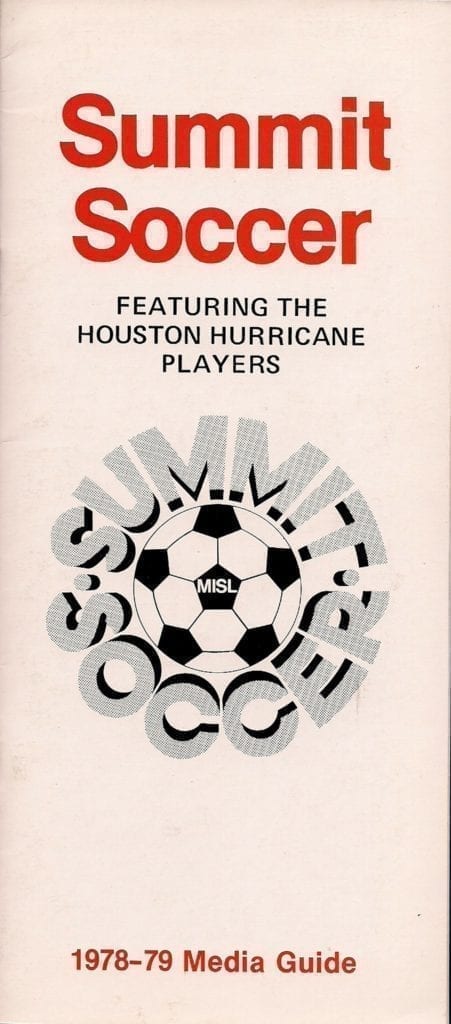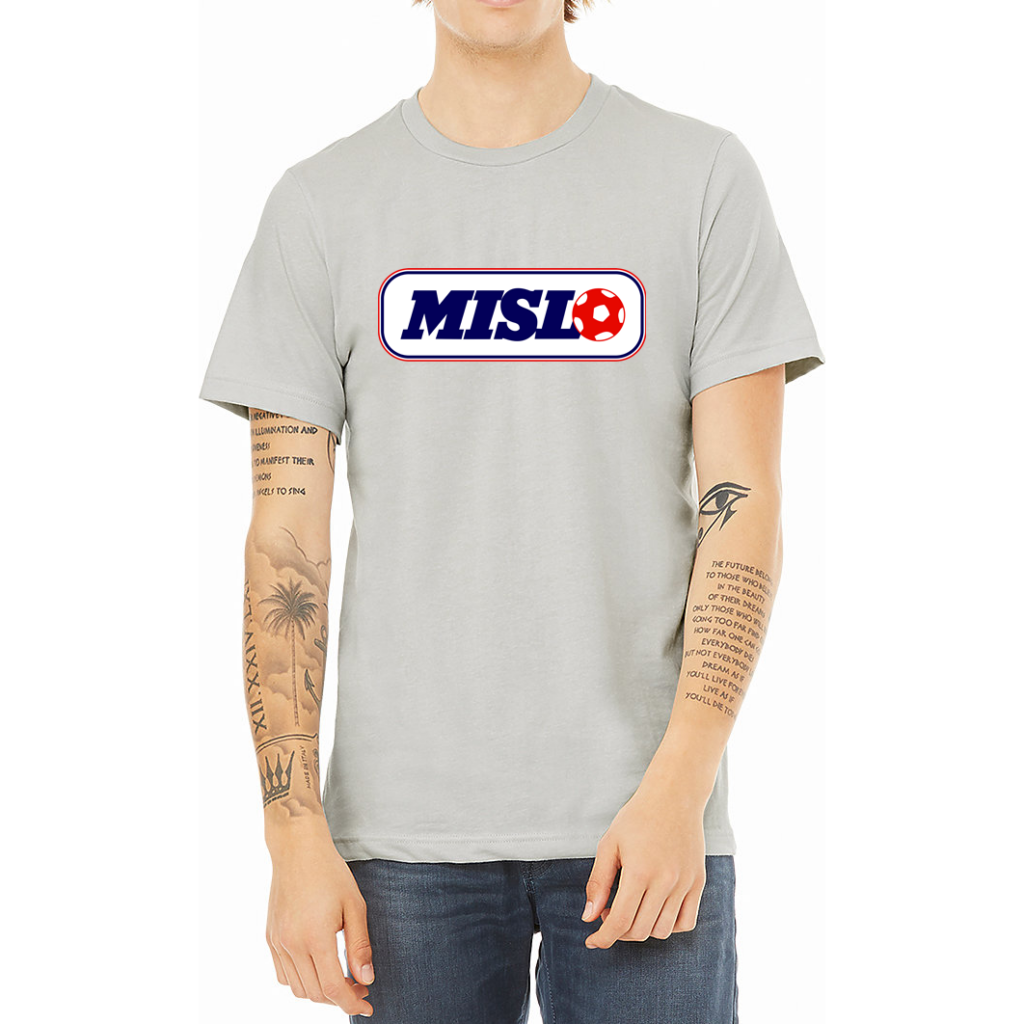Major Indoor Soccer League (1978-1980)
Tombstone
Born: September 1978 – MISL founding franchise
Moved: May 1, 1980 (Baltimore Blast)
First Game: December 26, 1978 (W 10-3 vs. Cleveland Force)
Last Game: March 23, 1980 (L 7-4 @ New York Arrows)
MISL Championships: None
Arena
The Summit (15,208)
Opened: 1975
Branding
Team Colors:
- 1978-79: White, Red & Orange
- 1979-80: Orange & Maroon
Ownership
Owners:
- 1978-79: Arena Operating Co.
- 1979-80: Bernie Rodin
Attendance
Tap (mobile) or mouse over chart for figures. Tilting your mobile device may offer better viewing.
Source: Kenn.com Attendance Project
Trophy Case
MISL Goalkeeper of the Year:
- 1978-79: Paul Hammond
- 1979-80: Sepp Gantenhammer
Background
If you can’t buy a championship calibre team, rent one. It’s an unusual approach in American sports, to be sure, but not unprecedented, particularly in the world of soccer. Faced with a hurried 1967 launch to keep pace with a competitor, Jack Kent Cooke and Lamar Hunt’s United Soccer Association (USA) consisted of twelve imported European and South American club teams who spent their offseasons playing under pseudonyms in American cities.
In the fall of 1978, Earl Foreman, the former owner of the USA’s Washington Whips, announced the formation of the six-team Major Indoor Soccer League (MISL). With only two months to assemble rosters before the MISL’s December 1978 launch, two clubs – Houston Summit Soccer and the New York Arrows – elected to lease rosters from nearby North American Soccer League (NASL) outdoor clubs.
Of the two, the Houston Summit took the more fully outsourced approach, striking a lease deal with the NASL’s Houston Hurricane for a full complement of 15 players plus the Hurricane coaching staff of Head Coach Timo Liekoski and assistant Jay Hoffman. The Arrows made a similar arrangement with the NASL’s Rochester Lancers, but unlike the Summit, the New Yorkers also signed a few players on their own, including the league’s eventual MVP Steve Zungul.
Management
Summit Soccer took its unusual name from its home arena, the $18 million Houston Summit, constructed in 1975. The team’s original owner was the Arena Operating Co., the private management company formed to operate the city-owned building by Summit developer and Houston Rockets NBA owner Kenneth Schnitzer. Arena Operating Co. reportedly took an interest in the start-up MISL to fill winter time dates at the Summit after the shut down of the Schnitzer-controlled Houston Aeros of the World Hockey Association during the summer of 1978. Summit arena President Burrell Cohen served a dual role as President and General Manager of Summit Soccer.
Debut Season
The rent-a-team model worked wonders for both Houston Summit Soccer and the New York Arrows during the 1978-79 MISL season. The Summit finished the regular season in first place among the MISL’s six clubs with an 18-6 record. The Arrows tied for second place at 16-8 and went on to win the championship after the Philadelphia Fever upset the Summit during the semi-finals. Summit forward Kai Haaskivi finished third in the league in scoring in 1978-79 with 39 goals and 64 points, and was joined in the MISL’s top ten by Ian Anderson, Stewart Jump and John Stremlau. Goalkeeper Paul Hammond posted a 13-3 record and a league-best 4.16 goals against average to earn 1978-79 MISL Goalkeeper-of-the-Year honors. Liekoski was named Coach of the Year.
In the spring of 1979, the NASL moved forward with plans for a full-fledged winter indoor league of their own, to head off the threat from the MISL. The Houston Hurricane announced their intention to play NASL indoor soccer in Houston and that they would therefore terminate their agreement to loan players to Houston Summit Soccer for the 1979-80 season. But the Summit was the only suitable site in Houston that met NASL standards and Arena Operating Corp. controlled it. When the 1979-80 NASL indoor season kicked off in November 1979, only 10 of the 24 NASL clubs participated. The Hurricane sat out the season.
Final Campaign
Meanwhile, Arena Operating Corp. got out of the professional soccer business. New York developer Bernie Rodin, a part owner of the NASL’s Rochester Lancers, purchased Houston Summit Soccer in 1979. The price was reportedly between $500,000 and $1,000,000.
Liekoski departed as Head Coach and Rodin replaced him with former Dallas Tornado player Kenny Cooper. On the field, Houston Summit Soccer didn’t miss a beat under Cooper. The club finished the 1979-80 season in first place in the MISL’s Central Division with a 20-12 record. Haaskivi once again finished third in the league in scoring. Sepp Gantenhammer replaced the departed Paul Hammond in goal and, like Hammond the year before, earned MISL Goalkeeper-of-the-Year honors. In the playoffs, Summit Soccer swept the expansion Wichita Wings in the semi-finals to earn a spot in the title game against the defending MISL champion New York Arrows at Nassau Coliseum in March 1980. The Arrows defeated Summit Soccer 7-4.
Move To Baltimore & Aftermath
Off the field, the Summit ranked near the bottom of the ten-team MISL in attendance in 1979-80. Rodin pegged his operating losses in Houston at $750,000 for the season. In late March 1980 as the Summit advanced through the playoffs, team and league officials acknowledged that Rodin intended to move his club to the Baltimore Civic Center for the 1980-81 season.
On March 27th, 1980 the Houston Hurricane filed suit against Houston Summit Soccer. The NASL club sought to block the move until Rodin repaid $94,560 in player loan fees and other claims. The suit delayed the move only temporarily and the club’s arrival in Baltimore was made official on May 1st, 1980. The Baltimore Blast became one of the most enduring and successful indoor soccer teams of the 1980’s.
Bernie Rodin sold the Blast in February 1984 to Nathan Scherr, a man who had never seen an indoor soccer game, for $2.9 million.
The franchise that began life as the Houston Summit in 1978 lasted until 1992. The original Baltimore Blast folded along with the rest of the MISL in July of that year. Kenny Cooper moved with the team from Houston and coached the original incarnation of the club for its entire existence in Baltimore. The name has subsequently been revived by a successor club that also plays at the Baltimore Civic Center.
Houston Summit Soccer Shop
Our Favorite Stuff
MISL Logo T-shirt
The Major Indoor Soccer League (MISL) kicked off in 1978 with six teams. At its peak, it boasted 14 teams with many drawing sell-out crowds. Remember the MISL in the great logo T-shirt from Royal Retros. Available in white and navy blue too!
[auction-nudge tool=”listings”]
Houston Summit Video
The Summit take on the Wichita Wings in playoff action at the Kansas Coliseum. March 18th, 1980 .
Links
###



One Response
Loved the article and I even recomended it to my readers of my blog. Well done!